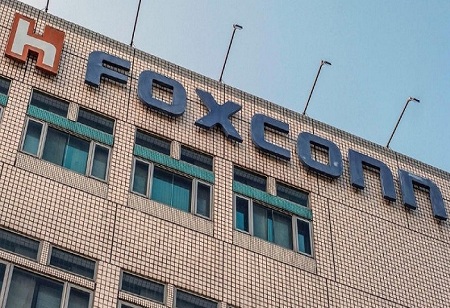The world's largest electronics contract manufacturer and the Taiwanese government are looking into a partnership that would enable Foxconn to quickly upgrade Indian workers' abilities to meet the demands of the semiconductor industry. According to those with knowledge of the situation, the strategy is to use Taiwan Education Centres (TEC) spread around India to train local technology experts using Foxconn's proprietary technical materials and Mandarin language offered by the TECs. This language and technical combination would help close gaps between Taiwanese and Indian talent and businesses.
India may be able to play a big role in the developing global chip warfare with the help of a coordinated effort from the Taiwanese government and corporate sector to train Indian technical talent for the semiconductor industry. Despite the fact that formal conversations have not started, both sides also expect to discuss the issue with the Indian government, according to the aforementioned individuals who asked to remain anonymous.
With a 1.54 trillion investment plan with mining company Vedanta through a 40:60 joint venture for building a display fabrication unit, an integrated semiconductor fabrication unit, and an outsourced semiconductor assembly and test (OSAT) facility in Gujarat, Taiwanese electronics giant Foxconn, Apple's largest supplier of iPhones and iPads, is betting big on the semiconductor market in India. The company also intends to utilise the 76,000 crore financial incentive programme put in place by the government to promote semiconductor production. On January
12, Mint reported that the Gujarat proposal from the joint venture between Vedanta and Foxconn was probably going to be the first to receive official approval. The concept for a skilling partnership between the Taiwanese government and Foxconn becomes relevance considering the manpower shortage that afflicts the semiconductor sector globally and the significant investments planned for the Indian market. For instance, according to Accenture, the US need 70,000 trained workers to manufacture vital high-tech semiconductors. 350,000 to 400,000 skilled workers are required in China as well, which plans to offer incentives totaling $143 billion in exchange for assuring semiconductor independence.
Such a plan would enable India to cultivate a globally competitive pool of talent while also providing Foxconn with a ready base of talent to draw from in order to fulfil its own requirements. This is because the semiconductor industry is expanding quickly worldwide and there is a growing shortage of skilled talent.
To provide Indians with Mandarin language instruction, the Taiwanese government has funded the creation of TECs. The Taiwan Economic and Cultural Centre (TECC), which serves as the island nation's embassy in New Delhi, is in charge of running these institutions. TECs are currently supported by Taiwan's education ministry, and there are 18 of them nationwide. As of publication time, neither Foxconn nor the Taiwan Education Centre at National Tsing Hua University had responded to inquiries.
India is also revising its educational regulations to include training and certification programmes for developing a labour force that the semiconductor sector can use. In an interview last month, Rajeev Chandrasekhar, minister of state for electronics and information technology and minister of state for entrepreneurship, stated that the government had developed a comprehensive framework of courses, degrees, doctorates, post-doctorate, and certification programmes in collaboration with the industry. This framework was being implemented by the All India Council for Technical Education (AICTE) and the other departments. The workforce will be employable by the sector thanks to the framework or blueprint developed by a committee led by AMD country chief Jaya Jagadish.
"We have something called Future Labs, which is where we incubate and rebuild new technologies for the future; future skills in terms of the skills that our digital economy requires today and tomorrow; and then future design, which is essentially to do with what will be the innovation and design across the technology space; so that by academic year 2023–24, the higher education system will start delivering on the talent required for semiconductors.
